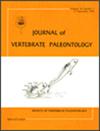A new squaloziphiid-like odontocete from the Early Miocene of Patagonia expands the cetacean diversity in the southwestern Atlantic Ocean
IF 1.9
4区 地球科学
Q2 PALEONTOLOGY
引用次数: 0
Abstract
ABSTRACT The Early Miocene Gaiman Formation, from Argentina, houses a taxonomic variety of odontocetes, mainly dominated by platanistoids and physeteroids. In this work, we describe a new medium-sized odontocete, Crisocetus lydekkeri gen. et sp. nov., based on a partial skull, which expands the diversity of odontocetes in the Early Miocene beds of Patagonia (Argentina). The phylogenetic analyses placed C. lydekkeri within the crown Odontoceti, stemward to delphinidans, ziphiids, and physeteroids. Crisocetus lydekkeri displays a set of characters that are shared with the members of the Squaloziphiidae family (i.e., Squaloziphius emlongi and Yaquinacetus meadi), such as a massive postglenoid process of the squamosal, ventrally longer than the posttympanic process and the exoccipital; apex of postglenoid process anteroposteriorly longer than transversely thick; presence of a deep emargination by a neck muscle fossa on the posterior end of the zygomatic process; basioccipital crests forming an angle of circa 70–90°; and a basioccipital width wider than 51% of the skull width in ventral view. Thus, we recognize a squaloziphiid-like morphology shared by C. lydekkeri, S. emlongi, Y. meadi, and even Dolgopolis kinchikafiforo. Our phylogenetic analyses partially support the inclusion of C. lydekkeri within Squaloziphiidae, however this family is recovered with low support. Finally, the presence of C. lydekkeri and even D. kinchikafiforo in the Early Miocene of Patagonia expands the paleogeographic distribution of squaloziphiid-like forms to the southwest coast of the Atlantic Ocean, suggesting that these taxa had an almost antitropical distribution.来自巴塔哥尼亚早中新世的一种新的类鲨齿兽扩大了大西洋西南部鲸类动物的多样性
本文章由计算机程序翻译,如有差异,请以英文原文为准。
求助全文
约1分钟内获得全文
求助全文
来源期刊
CiteScore
2.90
自引率
7.10%
发文量
58
审稿时长
4-8 weeks
期刊介绍:
The Journal of Vertebrate Paleontology publishes original contributions on all aspects of vertebrate paleobiology, including vertebrate origins, evolution, functional morphology, taxonomy, biostratigraphy, phylogenetics, paleoecology, paleobiogeography, and paleoanthropology. JVP publishes high quality peer-reviewed original articles, occasional reviews, and interdisciplinary papers. It is international in scope, and emphasizes both specimen- and field-based based research and the use of high-quality illustrations. Priority is given to articles dealing with topics of broad interest to the entire vertebrate paleontology community and to high-impact specialist studies. Articles dealing with narrower topics, including notes on taxonomic name changes (unless these deal with errors published in JVP), preliminary site reports, and documentation of new specimens of well-known taxa, are afforded lower priority.

 求助内容:
求助内容: 应助结果提醒方式:
应助结果提醒方式:


